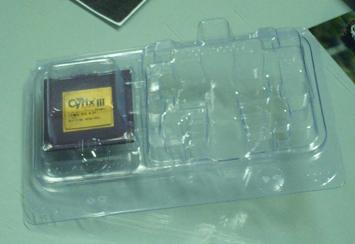VIA Cyrix III 533, 600MHz (1/4)
Posted by Wesley on
The CPU industry for IBM compatible (or non-Mac) personal computers was pioneered by, and still dominated by Intel, the creator of modern microprocessors. Many companies have tried to take a bite out of this ever-growing market with varying success. The most prominent competitors were Advanced Micro Devices (AMD) and Cyrix. These two companies gained notable market shares by attacking value-oriented low-end segment of the industry in the last few years.
Even though Intel tried to cut off the competition by suddenly moving to Slot1 design for processors in 1997, AMD and Cyrix improved the Socket7 design thrown away by Intel to come up with 'Super7', which became a viable and cost-effective alternative to Slot1 and the two companies remained competitive. Seeing their little success in the low-end, many companies like Centaur and Rise sprang up to provide their own version of the Super7 processors.
Unfortunately, though, in 1999, nearly all of the competitors to Intel faced collapse due to many factors such as aging of the Super7 platform and problems with ramping up speed or production target. Cyrix and Centaur was eventually bought by Taiwan's VIA Technologies and Rise switched their target market to internet appliances, disappearing from the PC scene. AMD was on the verge of bankruptcy while their K6-III had trouble producing in volume. That's how Cyrix, Centaur, and Rise virtually disappeared. But...
In case of AMD, however, their unusually high devotion to R&D department in the last couple of years had paid off, and their K7 processor, renamed and now known as Athlon, was able to meet or surpass Intel's high-end offering, the Pentium III on both performance and price-competitiveness. Because of this chip and its siblings that followed such as Duron and 'Thunderbird', AMD made a strong comeback and is now viewed as a significant competitor to Intel. This trend is still picking up the pace - the latest additions to this include Intel's 2000 Q3 earnings warning in which many are thinking that AMD's gain in the market share played a significant role.
So what we are now seeing is that the PC industry is enjoying a true 'duopoly' of Intel and AMD, the two companies' combined market share being more than 99%. The two companies have almost the same line-up of ultra high-end to value low-end processors already in mass production or going into production in a few months, thus overlapping each other in every aspect and having fierce competition. All the while the other PC processor companies remained in virtual silence....
Until now.

What you see above is a VIA Cyrix III 600MHz processor in a plastic box that goes inside the retail package. The hollow area on the right of the box is where the heatsink/fan goes in. I was shocked to see this handed to me for a review because I've not heard of Cyrix much since it was absorbed by VIA more than a year ago. I did hear about this chip occasionally, but it was constantly being delayed that I thought I would almost forget about it. This product is going to be available on the market almost immediately, so I can pretty much say that Cyrix has finally made a comeback. It is quite evident that, because of all the spotlight being focused at Intel and AMD, Cyrix's re-entry was rather quiet.